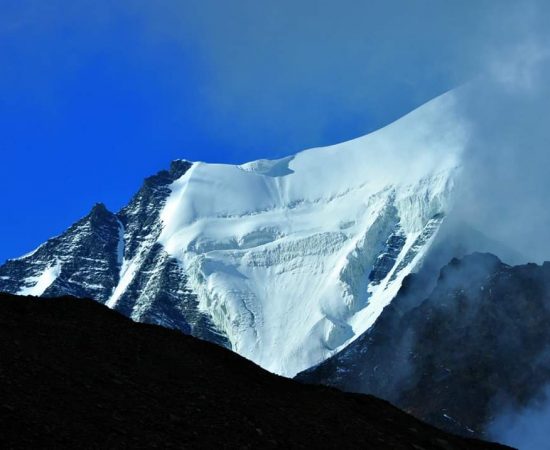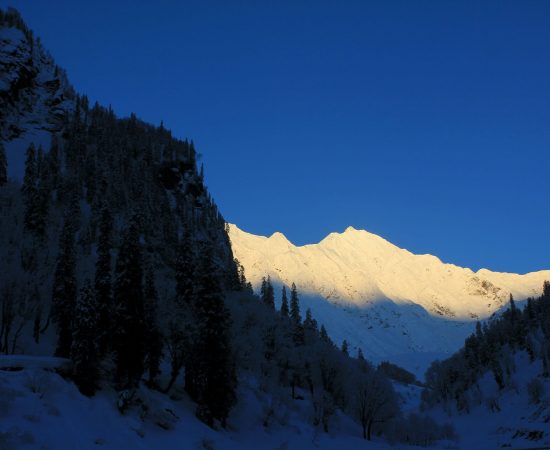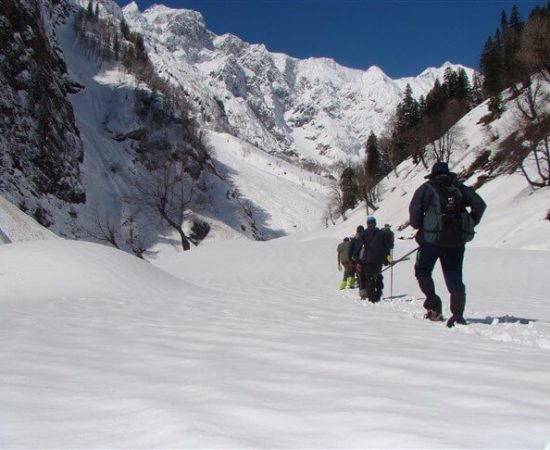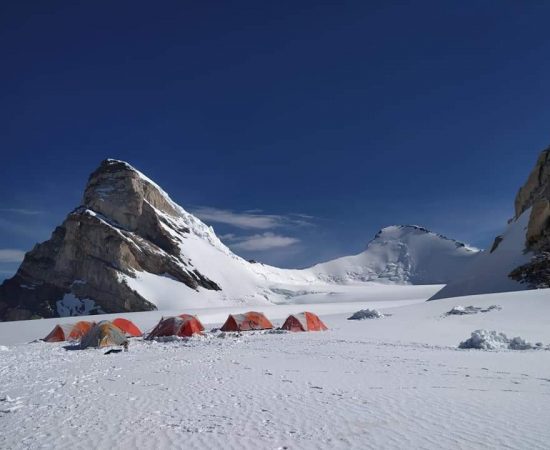Manirang Expedition
Spiti, Himachal Pradesh
Rated 4.9/5.0 on TripAdvisor. 550 Reviews


Key Highlights
- Altitude : 6593 m./ 21625 ft.
- Time : 19 Days - 18 Nights
- Region: Spiti
- Best Time: June-October
- Grade: Difficult
Overview
Manirang Expedition
Manirang, the border mountain between the Kinnour and Lahoul Spiti districts of Himachal Pradesh, is the state's least well-known mountain. It stands at a lofty 6593 metres, making it one of Himachal Pradesh's tallest crowns. The Manirang Peak may be reached through Manirang Pass, a short cut that was formerly used for commercial purposes as part of the route between Spiti and Kinnour. The top was difficult to reach since the area had been isolated for so long. Nonetheless, a modern road has been constructed, and the area is beginning to gain some notoriety outside its borders. The mountain is situated in a hard area of the nation, where flora is rare and rocky distances are mind-boggling. It was crucial to carefully navigate the harsh climate, razor-sharp ice cliffs, craggy hills, undulating landscape, and moraines. It is required that you have prior experience climbing in demanding environments due to the peak's high height and technical challenges. Humans tend to prefer drier climates, so they dwell in areas with less rain. However, the weather at higher elevations is much more severe and unpredictable. Therefore, the trek to the summit of Manirang Peak begins at the town of Mane, the route's last habitat, and continues on via Sapena, Rankali, and Pankit lands. It's a long, slow journey across huge plains, reddish brown mountains, and many rivers that are too cold to swim over. The rolling over of slopes will continue, and the raging river will seem to cross once again. We'll be setting up several camps along the way to the final destination. Moving on, the moraines will reveal their sheer occurrence, followed by scree slants and extensive boulder fields all the way to camp I, and then we'll follow the river to camp II, where we'll get our first look of the beautiful Peak. When you leave Camp II and go toward Manirang Pass, you'll see huge ice fields. As we near the pass, the terrain changes from scree to steep slopes covered with large rocks. Reconnaissance work is required the next day before making an ascent attempt. The last ascent to the peak is treacherous, since it is littered with loose stones that are themselves encased in solid ice, and the gradient continues flattening off. This ascent over a variety of terrain requires extreme caution. After a lot of hard work, you'll reach the top, where you'll be rewarded with spectacular views. From the summit, you can see much of the Himalayas rising above the clouds in every direction. There will be a hurried Puja to pray for a safe journey down the mountain. Overall, paying tribute to the lovely peak and isolated people by experiencing some of their struggles in such arid areas is possible for those who undertake the Peak less known.
Cost Per Person
Key Highlights
- Altitude : 6593 m./ 21625 ft.
- Time : 19 Days - 18 Nights
- Region: Spiti
- Best Time: June-October
- Grade: Difficult
Complete
Itinerary of Expedition
The team is scheduled to arrive in Manali in the morning on this day. After reaching Manali, make your way to the appointed lodging(details of your accommodation will be shared in advance before your arrival) where you will be received by a representative from Himalayan Adventure Trips. After freshening up, we will proceed with our briefing session regarding the expedition where you will be required to present certain documents like Photo ID, registration form, etc. for administrative paperwork. As you finish all the formalities, you will get time to explore the local sights in the area like Vashisht hot springs and Hidimba Devi temple. Evening time can be used to bond with the rest of the team over dinner. Overnight stay in a hotel/guest house.
We will depart early in the morning for Kaza which is the commercial capital and the main township in Spiti valley. It is advised to leave as early as possible as there might be heavy traffic during season time. Enjoy the scenic drive through the rugged yet mesmerizing landscape of Lahaul and Spiti valley while crossing high mountain passes like Kunzun La. We will reach Kaza late in the afternoon as it takes approximately 8 hours to reach. Check in to the designated lodging and relax after the long ride. In the evening you can take a stroll around Kaza and visit the local market and monastery, while witnessing the unique and rich culture of the region. Overnight stay in a guest house.
Today, we’ll be making our way to the quaint village of Mane which is situated near the border of Kinnaur and Spiti. These two districts in Himachal Pradesh are unique for their heritage and Buddhist influence. The drive is short and takes around 2 hours to Mane. At the end of the drive we have to cross the Spiti river in order to reach Mane village. On reaching Mane, we will stay at a delightful yet rustic homestay in the area. Acclimatization is integral for the success of any mountaineering expedition, so, in the after the whole team will gather and leave for a brief acclimatization walk in one of the surrounding trails. Enjoy a nutritious and scrumptious meal at the homestay and relax for the night, as the true test of endurance and mindset begins the next day. Overnight stay in a homestay.
The first day of the expedition on foot finally begins from this day onwards and trekking through the dry and desolate landscape of Spiti valley can be taxing for anyone. As there is barely any kind of vegetation or shade in the alien-like landscape. The only vegetation that one can notice are the thick shrubs of juniper which the locals use in their prayer rituals. We will pass through a narrow valley and reach our campsite. In the 1994 British Kinnaur expedition, this campsite was named as Saponang campsite as it falls right under the mighty peak Saponang(5836m). We will halt here for the night and prepare ourselves for the next day’s journey to the base camp. Overnight stay in tents.
Today’s trek is rather short but doesn’t fall short in giving a tough challenge to the team. We will continue our ascent through the narrow valley and pass through terrains of scree. This is what makes this trail even more difficult and consumes a lot of time. On reaching the base camp we will have a clear view of Manirang peak towering above and also Manirang pass, which we will use to climb onto the southwest ridge of the peak. We will set up our base camp, this is going to serve as our base in attempting the summit of the peak and also help us in setting up our higher camps. Overnight stay in tents.
Since we have gained significant altitude in the past few days it is important that we rest our bodies and help ourselves acclimate to the harsh conditions in the high altitude. We will proceed with the day in a relaxed manner with light activities like distributing our equipment and ration for the expedition ahead. The base camp is the last location till where our donkeys/mules can carry our load. From here onwards it is all up to us to carry the load and establish the higher camps. Overnight stay in tents.
The ascent from the base camp to Camp 1 is rather tricky and requires careful navigation through glacial and moraine fields. Carrying load can be even more tricky so we take our supplies bit by bit to avoid any kind of risk. We might even have to rope up for safety. Camp 1 is situated right below the ice wall which leads up to Manirang Pass. We will pitch a tent and keep dumping most of our stuff at the campsite in these three days. This kind of activity aids in acclimatizing our body to the altitude and the surroundings. The dry and desolate terrain of Spiti valley makes the conditions even more harsh. Overnight stay in tents at the base camp.
Today, we will finally make our way up to camp 1 and occupy it. Overnight stay in tents at Camp 1.
Camp 2 of Manirang peak is situated on the high glacial plateau below Manirang Pass which was a historical trade route. The Spitians called it 'Ropakla' as it led to the Ropa village in Kinnaur. The pass is now in total disuse as trade is carried out through the motorable roads, though they are about 250 km longer. The route is extremely tricky so a lead climber will go ahead to fix the rope at multiple points so that other climbers can attach their jumars and climb with relative ease with the kind of weight they are carrying to Camp 2. The trickiest part is navigating between the hanging glaciers. We will set up camp 2 below and the pass and like what we did with camp 1, we will dump most of the supplies as possible and then descend back down to camp 1 and spend the night there. Overnight stay in tents.
We will use the same fixed lines to climb back up to Camp 2 and this time we will halt there. Overnight stay in tents at Camp 2.
The climb to the summit camp involves taking a right from Manirang Pass and beginning our ascent on the southwest ridge of Manirang peak. The team gets a strategic advantage for the summit attempt. The ridge is a 50 degree slope at almost 6000 meters which makes it a heavy challenge on any mountaineer. We will reach the summit camp in the afternoon and take as much rest as possible for the summit push.
The day of reckoning starts way before dawn to give us the perfect conditions to make the climb. The summit march requires us to curve around the slopes to get the best possible route to climb to the summit. From the summit you can get a clear vantage point to witness the Kinnaur and Spiti valley along with the surrounding peaks such as Rangrik Rang, Mangla Peak, Karcha Parbat, Saponang Peak, etc. After spending some time on the summit we will begin our descent as we will have to wind up the summit camp and make our way down to camp 2. After our tiresome endeavor today, we will take some rest at camp 2 as we will have to climb down the tricky route back to base camp. Overnight stay in tents at Camp 2.
We keep a day as our reserve day if in any case the weather does not permit us to go for the summit attempt on the designated day.
We will use the fixed lines which we used to climb up but this time we will climb back down to base camp winding up the high camps and retrieving all the equipment that we used. Overnight stay in tents at base camp.
With high spirit the whole team will descend back to Mane village. Celebrations are in order after the arduous journey that we took to the summit. Rejoice with the locals and teammates in the evening and sing songs of victory. Overnight stay in homestay.
Board the vehicles early in the morning and depart back to civilization reflecting on the incredible experiences and memories of the expedition while on the scenic route. Reach Manali in the evening and check into your lodging. Relax and unwind in the comforts of a cozy bed and a hot shower. Overnight stay in a hotel/guest house.
After breakfast we will bid goodbye to each other and conclude the marvelous himalayan expedition.
Enquiry For Group Bookings
Guidelines
➽ Preparation for Expedition
As you well know, the great Himalayan expedition is one that requires careful preparation, a strategy that allows for enough flexibility to adapt to whatever challenges may arise.
Therefore, here are some things to consider before setting out on your Manirang Expedition:
⦿ Physically – You should start working out at least a month before signing up for a program if you want to be physically prepared for the rigours of a journey. Strengthen your legs by jogging and working out regularly to increase your stamina. To better acclimatise to the environment and increase your resilience on the walk, you should give up smoking and undertake breathing exercises twice a day. Engage in vigorous physical activity, such as playing sports, doing Yoga, or running.
⦿ Mentally –
Getting in shape physically is essential, but mental preparation is just as crucial for a successful walk. Take time to enjoy your regular activities, maintain a healthy diet and sleep schedule, and unwind before embarking on a hike. Predictions regarding the journey should not cause mental worry. Spend time with your closest pals to recharge your batteries and renew your spirit. Pre-trek preconceptions are unwarranted since the first contact with the other trekkers is certain to be a source of inspiration and energy. Conditions during the walk will contribute to the increase in mental readiness. The mental repercussions of physical disadvantages will not be ignored. So, when you hike, pay attention to different regions of your body and purposefully relax them. If you want to enjoy your hike, you should learn to loosen up a little, particularly in the hips. Think about your descent as a simple dance, and enjoy the natural rhythms that the path and your body can discover together gradually, whether you're on a flowing downhill route or a frightening slope. Try out a few new walking techniques to add some fun to your commute without worrying about getting somewhere in particular. Maintaining mental fitness mostly requires a willingness to relax and take in the journey, rather than subjecting oneself to undue stress.
Guidelines
➽ Things to Carry
- Good Trekking Boots: You need sturdy trekking boots with supportive high ankles. Don't bring your running shoes. U can carry extra floaters/flip flops also.
- Wear warm clothing, such three-layer coats, fleece upper, hollow fill or down-filled jackets. Carry full-sleeved T-shirt. Carry cotton hiking trek pants and warm pant for your lower body. Never bring shorts or jeans on a hike.
- Take top and bottom thermals with you.
- Quick dry towel with light weight and Personal toiletries. Suns cream lotion, sanitizer, tooth brush ad toothpaste, lip balm and antibacterial powder.
- Socks: Bring two pairs of regular socks and two pair of wool socks for wearing at night.
- A head torch is required.
- Sunglasses/ Goggle: UV-protected sunglasses are necessary to protect against sunlight and Snow Mountain.
- There should also be a woolen cap / balaclava, cap, neck gaiter cum face mask and warm fleece and waterproof summit gloves since it will be chilly. Keep waterproof gloves on hand since they become wet in the snow.
- Everyone taking part in the activity should have their own lunchbox, spoon, mug and water bottle/ hydration pack of 2 ltr.
- Raincoats/ponchos: Since snowfall and rain are frequent at high elevations, it is important to have one on hand so as to avoid getting wet.
- Trekking bag of 75 ltr with rain cover.
- Walking stick.
- Personal first aid box. Emergency ration, energy bars, dry fruit, electoral/Ors
- Personal technical gears list of mountaineering (on rent basis available)
- Climbing boot, Crampon, Sleeping bag (optional), Ice axe, seat harness, Rope and tape sling, helmet, Summit gloves, Gaiters, Carabineers 2 no (screw), figure of eight/descendor, Zumar (Ascendor),
- Required Documents:
a) Registration Form
b) Medical Certificate (signed by a licensed MBBS physician)
c) NOC form (completed by the trekker)
d) 2 passport-size photos
e) ID Proof photo (not PAN)
f) Basic Mountaineering Course certificate.
g) Insurance upto 5 lac..
Guidelines
➽ How to Reach
How to reach Manali:
Delhi and Manali are linked nicely. You may travel from Delhi to Manali in 12 to 14 hours via overnight bus (approx 540 KMS). Online ticket reservations are available at www.redbus.in and www.hrtc.gov.in Tip: Given the distance between Delhi and Manali, the majority of Volvo private buses depart Delhi between 5 and 8 p.m. At 8.30 p.m., the final government bus departs from ISBT Kashmere Gate. Between Rs. 1,200 and Rs. 1,800 are charged by Volvo buses each sector from Delhi to Manali and vice versa. Delhi to Manali: Buses depart from Manali for Delhi between 4 and 8 p.m., same like the return trip. You should expect to arrive in Delhi any time between six and ten in the morning. Plan your subsequent trips just after midday, leaving ample time for bus delays.
How to reach Naggar:
Naggar is 18 kilometres from Manali, and there are several buses that operate every 15 minutes. Alternatively, one may get out at Patlikuhal, which is 5 kilometres from Naggar on the right bank highway. Between Kullu and Manali is Patlikuhal. To get to Naggar, you may take a cab or a local bus from Manali or Patlikuhal.
The closest train station is:
Ambala (350 miles) and Chandigarh are the closest railway stations (310 kms). Advice: From Chandigarh to Manali, regular buses and Volvos run in the evening. Volvo buses from Chandigarh to Manali and vice versa charge between Rs. 800 and Rs. 1,200 every sector.
The closest airport:
The closest airport to Manali is Bhuntar, which is 52 kilometres distant. From Bhuntar to Manali, taxi services are available and cost between Rs. 1500 and Rs. 2,500. Air travel between Bhuntar and Delhi is convenient. Airlines providing flights from Delhi and Chandigarh to Kullu include Indian Airlines, Kingfisher Airlines, MDLR Airlines, and Jagson Airlines.
➽ Trip Cost Includes
- Mountaineering (Instructor/guide) services provided by a highly trained, professional, and qualified Himalayan Adventure Trips staff.
- Certified local guide with extensive familiarity of the area.
- Climbing provides only vegetarian food (breakfast, lunch, and dinner).
- Staff include chefs, cooks, and helpers.
- High Altitude Force, Low Altitude Force, Porters, Mules for Common Equipment (Rations, Tents, Utensils, Central Climbing Equipment, etc.)
- Tents (to be shared), sleeping bags, air mattresses, and air pads are included. Inner
- We offer twin-share accommodations in dome, alpine, and high-altitude tents on all of our treks and expeditions. All necessary camping equipment, including air mattresses, a shelter for cooking and eating, a table and chairs, a stool, and more, would be supplied.
- Someone who can carry heavy items, set up high camps, repair ropes, etc. at high altitudes.
- Assistance from Guide All the Way to the Top
- High-altitude butane gas cooker
- The only meal offered at the hotel will be breakfast. All meals while on the walk will be supplied for you. Indian, Chinese, and Continental cuisines, all freshly cooked, will be on the menu.
- Tin-packaged food is what we'll eat at high altitude.
- A standard first aid kit with oxygen masks for the patient.
- Camping fees, wildlife fees, and forest permits.
- Taxes imposed by the state.
➽ Trip cost Excludes
- Climbers may hire individual porters to carry their gear.
- Airport transportation costs
- Expenses for carrying still/video cameras etc.
- Irregular/Personal costs, such as laundry, phone calls, and gratuities.
- Climbing equipment such as ropes, pitons, snow bars, crabs, etc.
- Your own personal mountaineering equipment and clothes, as well as any specialised foods you may need
- Inner Line Permit.
- Health coverage or the price of a rescue mission
- Expenditures of a more personal character (such as booze, soda, bottled water, mineral water, canned or bottled drinks, candy, canned or packaged dried fruits, etc.)
- Provisions/food to or from the starting point of the trek.
- Any expenses that are incurred as a result of natural disasters, human error, or other unforeseeable occurrences.
- Protect your trip with a travel insurance policy.
- Authorization, licensing, and enlistment with the IMF.
- Payment for Liaison Officer (included for foreign expedition only)
- GST of 5%.
Guidelines
➽ Special Casual Leaves
Government employee can avail the benefit of special casual leave when u join us for a trekking expedition. As per the rule of the pay commission, special casual leave can be availed for up to 30 days in a calendar years for trekking and mountaineering expeditions through a register organization. Himalayan adventure trips are a register adventure tour operator register with Indian mountaineering foundation and Himachal Pradesh tourism. Candidates have to apply for leave at least 30 days before the trek/expedition start.
Testimonials
➽ Provided By The Customers
Everything about our visit to Prashar lake was better than we could have imagined. From our initial contact with Himalayan Adventure Trips, we felt their genuine interest in learning about our group's goals and expectations, and our travels with them reinforced at every turn that they not only understood our requirements but also have the acute skill and expertise to achieve them. Having already had such a wonderful experience with this firm, I will be promoting a trek to Prashar lake to all my friends who share my passion for hiking and will specifically recommend that they work with this outfit. Absolutely fantastic; I have nothing but praise for it.
How useful was this post?
Click on a star to rate it!
Average rating 0 / 5. Vote count: 0
No votes so far! Be the first to rate this post.






